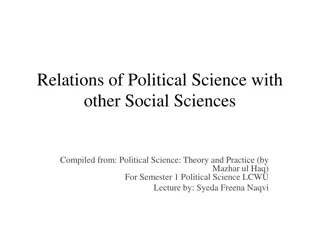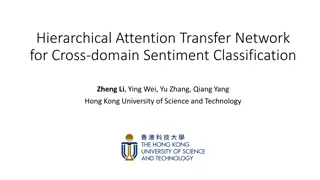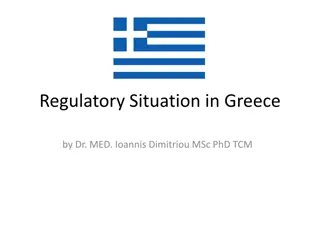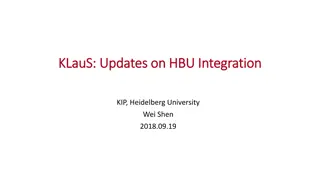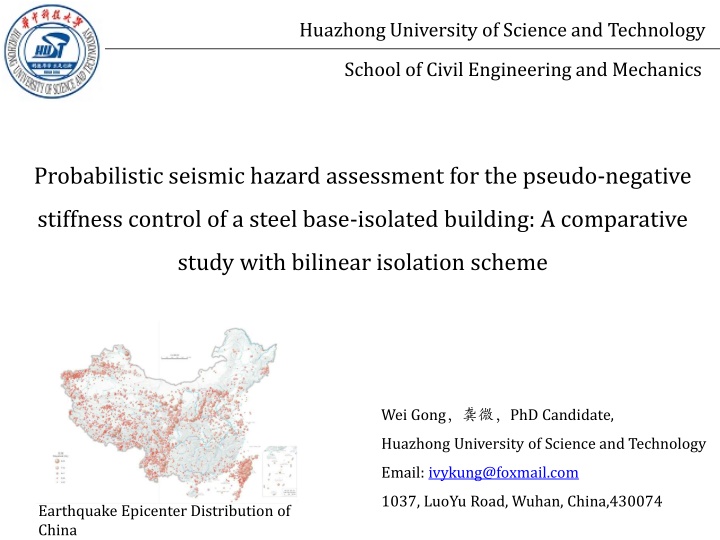
Probabilistic Seismic Hazard Assessment for Steel Base-Isolated Building Control
This study conducted at Huazhong University of Science and Technology explores the use of a pseudo-negative stiffness (PNS) control system for steel base-isolated buildings in seismic events. The research compares the effectiveness of this system with traditional bilinear isolation schemes. The study delves into the background, objectives, methods, and conclusions regarding the control mechanisms. It evaluates the seismic response control algorithms, including semi-active and active control techniques. The PNS control system is highlighted for its simplicity, safety, and reduced energy requirements while maintaining control effectiveness. The research aims to enhance the safety and reliability of base-isolated structures in earthquake-prone regions.
Download Presentation

Please find below an Image/Link to download the presentation.
The content on the website is provided AS IS for your information and personal use only. It may not be sold, licensed, or shared on other websites without obtaining consent from the author. If you encounter any issues during the download, it is possible that the publisher has removed the file from their server.
You are allowed to download the files provided on this website for personal or commercial use, subject to the condition that they are used lawfully. All files are the property of their respective owners.
The content on the website is provided AS IS for your information and personal use only. It may not be sold, licensed, or shared on other websites without obtaining consent from the author.
E N D
Presentation Transcript
Huazhong University of Science and Technology School of Civil Engineering and Mechanics Probabilistic seismic hazard assessment for the pseudo-negative stiffness control of a steel base-isolated building: A comparative study with bilinear isolation scheme Wei Gong PhD Candidate, Huazhong University of Science and Technology Email: ivykung@foxmail.com 1037, LuoYu Road, Wuhan, China,430074 Earthquake Epicenter Distribution of China
Huazhong University of Science and Technology School of Civil Engineering and Mechanics Background Background Objective Method Conclusion Flexibility Superstructure demands Base movement Upper connection plate Upper cover plate Internal rubber Internal steel plate New device brings new problem! Lower cover plate Lower connection plate
Huazhong University of Science and Technology School of Civil Engineering and Mechanics Background Background Objective Method Conclusion Structure control Isolation safety Isolation effective Reduce isolation effectiveness in superstructure response control Require large power supply and doubtable reliability Effectiveness + reliability + adaptability
Huazhong University of Science and Technology School of Civil Engineering and Mechanics Background Background Objective Method Conclusion earthquake structure response Is there a semi-active control algorithm simple? control device feedback sensor feedforward sensor control algorithm Conventional semi Conventional semi- -active control algorithm active control algorithm clipped-optimal control maximum energy dissipation modulated homogeneous friction fuzzy logic-based control Lyapunov control algorithm complicated computational process Complex massive sensing networks
Huazhong University of Science and Technology School of Civil Engineering and Mechanics Background Background Objective Method Conclusion pseudo-negative stiffness (PNS) control Force Force Force Displ. Displ. Displ. Force Force Force Displ. Displ. Displ. Bearing Force Control Force Total Force Input voltage reduced force transmission to the superstructure high damping ratio Displ. Effectiveness; Safety; Simplicity 1 Low energy source requirement 2 high control force base shear base displ. func. of displ
Huazhong University of Science and Technology School of Civil Engineering and Mechanics Background Background Objective Method Conclusion PNS control Less base shear Force to super. Large damping Base displ. A low base shear is not a guarantee of an real effective isolation system because the high modes, which carry both the floor acceleration and inter- storey drift, are almost orthogonal to the base shear. Less acc. & drift in super. (Kelly, 1999) acc. & drift in super base shear Can we get both? base displ.
Huazhong University of Science and Technology School of Civil Engineering and Mechanics Background Background Objective Method Conclusion variability in seismic intensity socio-economic Response quantities can't be always reduced simultaneously for a specific control strategy. Ideal Idealisolation isolation control controlprinciple principle Basic concept : different seismic intensity different control objective frequent earthquake improve the structural functionality acc. and drift in super. extreme earthquake improve the structural safety isolator displacement reduce the overall economic loss Ideal isolation control principle solves the conflict between iso. effectiveness and iso. safety.
Huazhong University of Science and Technology School of Civil Engineering and Mechanics Objective Objective Method Conclusion Background Modified PNS control MPNS Propose evaluate Deterministic Ideal Idealisolation isolation control controlprinciple principle Probabilistic Probabilistic seismic risk assessment Benchmark base-isolated building MPNS, PNS and passive damping control
Huazhong University of Science and Technology School of Civil Engineering and Mechanics Objective Method Method Conclusion Background Part 1: Modified pseudo-negative stiffness (MPNS) control energy dissipation capacity Control object: loosen the restriction on isolator displacement for low low- -to to- -moderate moderateseismic intensity V0=1 kpns=5 UT=0.2 prevent the relative movement of isolators for high high seismic intensity increasing the control force passive energy dissipation fashion V0 Implemented by MRD Force-displacement sketch of MPNS
Huazhong University of Science and Technology School of Civil Engineering and Mechanics Objective Method Method Conclusion Background Part 2: Deterministic assessment of MPNS control PGA = 0.139 g PGA = 0.8 g Acceleration (m/s2) Seismic input : El Centro x-direction Displacement(m) MPNS PNS Larger contr. force for MPNS Larger iso. displ. for MPNS
Huazhong University of Science and Technology School of Civil Engineering and Mechanics Objective Method Method Conclusion Background Part 3: Probabilistic seismic hazard/risk assessment (PSHA) of MPNS control Definition : Definition : estimate probabilities of exceeding various damage states for a certain damage measure Merit : Merit : consider various ground motions with different frequency contents frequency contents and intensities intensities explicit descript structural performances in probabilistic format scientifically complete Damage Measure (DM) Damage Measure (DM) : : EDP EDP Damage State Slight (LS1) Moderate (LS2) Extensive (LS3) Collapse (LS4) Inter-storey drift ratio 0.1% 0.2% 0.7% 1.5% Story acceleration(g) 0.05 0.1 0.2 0.4 Bearing displacement (m) 0.1D (0.06) 0.2D (0.12) 0.45D (0.27) min(0.55D,3Tr) (0.33)
Huazhong University of Science and Technology School of Civil Engineering and Mechanics Objective Method Method Conclusion Background Part 3: Probabilistic seismic hazard/risk assessment (PSHA) of MPNS control Nonlinear IDA Probabilistic Seismic Fragility Structure Hazard Site Hazard Scale up with IM IM Sa(T1) IM IM
Huazhong University of Science and Technology School of Civil Engineering and Mechanics Objective Method Method Conclusion Background Part 3: Probabilistic seismic hazard/risk assessment (PSHA) of MPNS control Site Hazard 1 Sa(2s) Sa(2.5s) 10-2 (im) 10-4 10-6 10-8 0.01 0.1 1 10 im (m/s2)
Huazhong University of Science and Technology School of Civil Engineering and Mechanics Objective Method Method Conclusion Background Part 3: Probabilistic seismic hazard/risk assessment (PSHA) of MPNS control Nonlinear IDA 63.2%50r 63.2%50r 47% 64% / 10%50r 10%50r 11% 20% / 2%50r 2%50r / / 9% 2%100r 2%100r / / 9% PNS-MPNS PNS
Huazhong University of Science and Technology School of Civil Engineering and Mechanics Objective Method Method Conclusion Background Part 3: Probabilistic seismic hazard/risk assessment (PSHA) of MPNS control Probabilistic Seismic Fragility
Huazhong University of Science and Technology School of Civil Engineering and Mechanics Objective Method Method Conclusion Background Part 3: Probabilistic seismic hazard/risk assessment (PSHA) of MPNS control Structure Hazard probabilities of exceeding DMs per 50 years PE in 50 years (10-2) Control scheme EDP >LS1 >LS2 >LS3 >LS4 21.0 48.1 63.2 76.1 99.7 95.9 66.1 52.1 60.4 2.0 2.3 5.4 36.7 96.3 72.6 27.9 21.3 23.5 MPNS PNS BIS MPNS PNS BIS MPNS PNS BIS 0.0 0.0 0.1 8.0 35.0 13.9 3.1 3.3 3.1 0.0 0.0 0.0 0.2 0.4 0.5 1.4 1.8 1.8
Huazhong University of Science and Technology School of Civil Engineering and Mechanics Objective Method Conclusion Conclusion Background A MPNS control scheme is proposed based on the ideal isolationcontrol principle. The effect of the MPNS controlis investigatedwithin a probabilistic performance-based seismic engineering framework in terms of structural functionality and safety. MPNS controlexhibits an enhanced ideal isolationcontrol capacity for improving structural functionalityto a substantial extent for low seismic intensities and for enhancing structuralsafety from collapse.
Huazhong University of Science and Technology School of Civil Engineering and Mechanics Thank you ~ Wei Gong PhD Candidate, Huazhong University of Science and Technology Email: ivykung@foxmail.com 1037, LuoYu Road, Wuhan, China,430074



